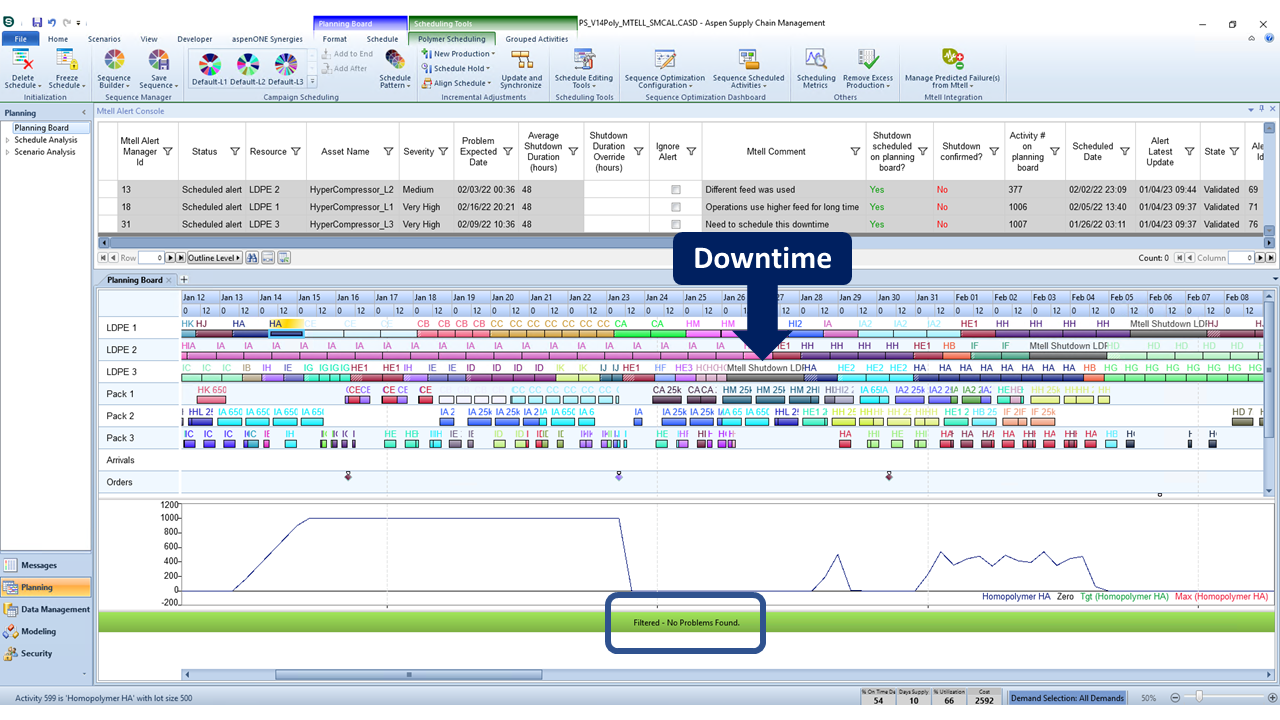In my old life as a maintenance and reliability engineer, firefighting was the name of the game. Most days, I didn’t know which machines would be working and which would be down by the end of the day. On the occasions when I did know about a breakdown before coming onsite, it was because of a 3 AM phone call about a critical system going down. Equipment would go down unplanned, production would stop, and our customer orders would be thrown into question.
Even when it was painfully obvious an asset was about to go down (such as a heat exchanger beginning to leak), finding downtime was never easy. I would work with planners to find time to schedule maintenance but finding downtime that was early enough and didn’t impact orders was incredibly challenging.
The True Cost of Unplanned Downtime
Maintenance and scheduling teams across many industries, such as polymers, specialty chemicals, pharmaceuticals, and others, understand the looming threat of unplanned downtime. As a maintenance engineer, I’ve seen air compressors go down unexpectedly and take down an entire site within a minute or two. This is a nightmare situation in which the costs of unexpected failures are significantly worse than planned downtime. Maintenance budgets can be heavily burdened by having to urgently bring rental equipment on site until repairs are completed.
Unplanned downtime can also blindside schedulers, effectively ruining production schedules and throwing customer order commitments into uncertainty. With how interconnected supply chains can be, this can spell doom for any sites that take materials from the initial plant, leading to a domino effect of failures across the network.
Why do plants struggle to plan and schedule downtime?
Planning downtime is an age-old battle between the maintenance and scheduling teams. Conversations on when to schedule downtime can lead to conflicts of priorities between departments. The scheduling team will try to push out shutdowns as far out as possible to minimize the impact on production. Schedulers are under pressure to keep production going constantly and meet order commitments. This is a direct conflict with maintenance, whose goal is also to keep production going by conducting repairs as soon as possible to remove the threat of equipment going down. There was a saying in my maintenance department, “If you don’t schedule maintenance for your equipment, your equipment will schedule it for you.” The longer you don’t do maintenance, the higher the risk to production.
To summarize, the key factors that make scheduling downtime difficult are:
- Not knowing when equipment will fail (unplanned downtime)
- Tradeoff between timely maintenance vs production and customer commitments
- Difficulty quantifying the production impact of scheduling decisions
These conflicting approaches and pressures breed conflict between departments, hindering teams from finding a solution while the risk of unplanned downtime continues to grow.
A Better Way: Predict and Schedule Downtime with Ease
There are two core solutions AspenTech offers that solve the maintenance and production scheduling issues related to downtime. Manufacturers across the globe have recognized these issues and taken steps to mitigate them by leveraging these technologies:
- Prescriptive Maintenance
Aspen Mtell® tackles the issue of unplanned downtime by using prescriptive maintenance to predict equipment failures/equipment maintenance from sensor data such as vibrations and temperatures. Aspen Mtell will show these as downtime alerts, along with how the failure will occur and what the next steps are. Giving up to 90 days in lead time on equipment failures, you can experience up to a 20% increase in asset uptime thanks to seeing breakdowns before they happen across many industries including bulk chemicals, specialty chemicals, polymers, pharmaceuticals and more.
- Production Scheduling
Aspen Plant Scheduler™ is a powerful, award-winning solution that can elevate site production with high-fidelity schedules. In one such case, a plant achieved a 20% increase in site throughput with a two-month payback period simply by leveraging out-of-the-box capabilities. Aspen Plant Scheduler helps you to increase site throughput and rapidly adapt to evolving supply chain complexities by enabling your scheduler to create and manage optimal production schedules.
The Next Step: Linking the Two Solutions
So, what’s the missing puzzle piece with these two technologies? The new V14 release of aspenONE® takes it to the next level by enabling synergy between prescriptive maintenance and production scheduling. Maintenance engineers can now send maintenance alerts from Aspen Mtell to Aspen Plant Scheduler for the production scheduler to find the best option for downtime in their schedules.
When incorporating these maintenance alerts, Aspen Plant Scheduler allows you to either create downtime scenarios with the drag-and-drop feature or let the optimization algorithm find the best option. The time window Aspen Plant Scheduler looks to place downtime is based on the equipment failure timeline provided by Aspen Mtell.
|
|
|
Video 1: Achieve resilient operations by synergizing production scheduling and predicting downtime together to find ideal downtime through Aspen Plant Scheduler and Aspen Mtell
|
Aspen Plant Scheduler not only streamlines the process of identifying when to schedule downtime, it also considers your customer commitments and related costs while minimizing the impact of downtime on your site. With the ability to create multiple scenarios and compare costs by categories like transition costs and setup time, the conversation of identifying downtime simplifies down to one with quantified impact. Conversations between departments can now take a few hours instead of weeks.
|
|
|
Figure 1: After inserting and optimizing the placement of downtime within the production schedule, Aspen Plant Scheduler shows no customer order issues, indicated by the green bar at the bottom and lack of red.
|
The Future of Scheduling Downtime is Here Today
Getting maintenance and scheduling teams to agree on planned downtime can be tedious and difficult, but no longer needs to be. With the new V14 synergy between Aspen Mtell and Aspen Plant Scheduler, you can predict equipment breakdowns up to 90 days in advance, and then find the best downtime schedule to make sure you keep delivering on customer commitments. It’s time to become proactive with predicting and planning your downtime to maximize your supply chain resiliency.
To learn more, watch this webinar we recently hosted: “Predict and Minimize the Impact of Equipment Downtime.”




.png?h=415&w=675&la=ja&hash=D2C92F80572E3197130298E780519542)
.png?h=415&w=675&la=ja&hash=CE8514A255ED1A9B00629DBF9C680D72)
Leave A Comment